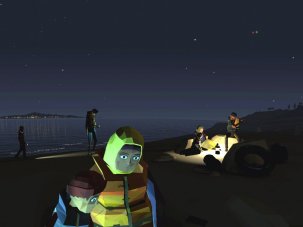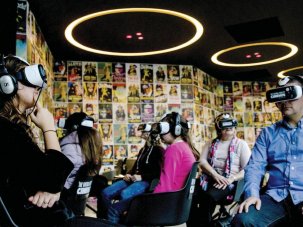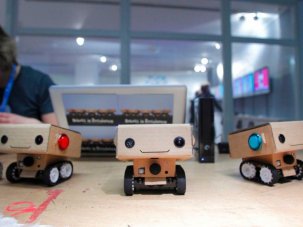New Frontier at Sundance has been showcasing work that explores crossovers of art and new technologies since its inception 11 years ago, shifting its focus to Virtual Reality for the past five. Throughout its growth and development, virtual reality has been debated and hypothesised: is it the future of cinema? Is it an empathy machine?
The mass VR experience is already being accommodated, with Amsterdam last year opening the world’s first Virtual Reality cinema. At Sundance the VR was so extensive that it spread across multiple venues, but the focus was still the individual experience. Waitlines gather for the most sought-after experiences. Geared up with a headset, the viewer loses their grasp on reality, while the queue looks on; it is not for the self-conscious. At Sheffield Doc/Fests past I’ve sat on the floor experiencing a virtual acid trip while a small crowd of festivalgoers observed, and while lost in a VR tour of Grayson Perry’s A House for Essex I walked into the venue’s wall. Virtual Reality unwittingly replicates the formula of a night terror, whereby the body is awake and engaging with the stimulus from the partially unconscious mind that is inhabiting a different space entirely. Which raises the question: what sort of space is it for people with phobias, anxiety and mental health issues?
The main festival venues at Sundance were the VR Palace – a pleasure dome in the snow – and the two-storey New Frontier hub on Main Street, the layout of which was more like an art gallery with displays and darkened rooms for the VR experience. Empathy, political engagement and hallucinogenic pleasure were the predominant themes.
The latter was exemplified by Tyler Hurd’s Chocolate, a virtual reality evolution of the music video. [See trailer above.] You’re a robot with canons for arms, shooting pink kittens into the sky while you dance surrounded by oozing chocolate mountains. The experience tickles like a firework display: catnip for the pleasure receptors, it leaves the user cooing with delight.
Further sensorial submergence came in the form of the Crystal Vibes experience, designed by Dr. Benjamin Outram. The synaesthesia suit, a 26-sensor full-body suit that combines audiovisual and ‘vibrotactile’ textures, was developed to embody the PlayStation game Rez Infinite. It vibrates with a complex neurological mapping of sound and colour – so the colours can be felt and heard, with the visuals a kaleidoscopic rave of patterns.
Milica Zec and Winslow Porter’s installation Tree involves both haptic perception and the performative, as the experiencer becomes the seed of a tree in the amazon rainforest. The ground beneath rumbles as you push your way through the earth and grow, the hand devices transforming your arms into branches. A cool breeze blows as night falls. It becomes hard to distinguish between natural responses and artificial simulation, as fire engulfs the forest and the chainsaw roars of loggers approach from the distance.
Zec and Porter’s previous piece Giant transplanted the viewer into a bunker in which a mother and father are telling their young daughter a fairytale to transform the bombs falling above into narratorial punctuation. Echoes of this empathy-building, fully immersive piece feed into the force of Tree, with its combination of visual and physical stimulation that sensorily transplants the viewer into the space and story.
A collaboration between Ashley Baccus-Clark, Carmem Aguilar Y Wedge, Ece Tankal and Nitzan Bartov, the NeuroSpeculative AfroFeminism installation seats the experiencer in a futuristic beauty salon as a black woman waiting for Octavia electrode implants – which are inspired by a real therapeutic treatment for depression and anxiety that was designed in a way that is incompatible with black women’s hair. The exhibition features imaginative beauty products that confront the challenges faced by women of colour. Designs include invisibility headgear for spaces that are predominantly white, in which the product reflects hostile behaviour back at the antagoniser, and earrings embedded with recording devices. The items have a dynamic mixture of aesthetics and politics, and engage the viewer in a dialogue addressing the need for protection against, and disruption of, racist behaviours and systems.
Life of Us (Chris Milk, Aaron Koblin) offered a shared experience of VR which transformed the story of evolution into a hilarious romp. Two participants are hooked up to the VR experience in separate rooms and plunged into a Darwinian adventure through time. The unique aspect of this installation is the shared experience. Your voices are warped into varying timbres that reflect your state of existence – from a tadpole to an avatar – and this added layer of frenetic fun and engagement makes the experience one of utter elation. Aside from the riotous euphoria, Life of Us indicated an interesting step towards deepening layers of engagement. One of the most powerful aspects that VR can offer is being confronted by another human: the experience of being seen.
Many VR experiences journey into war-torn territory and refugee camps, but the voyeuristic anonymity and detachment is whipped away when one’s cover is blown under the gaze of another human, particularly a real, non-computer-generated one, as in Milk’s previous work Clouds of Sidra. It is in the feelings of exposure and bewilderment that follow a perceived exchange with another intelligence’s reality that VR can transport you into new territory.
Aside from the installations, Sundance showcased a host of VR experiences that had a strong storytelling focus, such as the live action Miyubi from Felix and Paul studios, which experiencers have hailed as the closest VR has come to film. Whether for empathy or engagement, with political intention or pure entertainment, VR’s total hijack of the viewer’s reality opens up fascinating opportunities for the artist to experiment with how they communicate their visions, and the storytelling form.
-
The Digital Edition and Archive quick link
Log in here to your digital edition and archive subscription, take a look at the packages on offer and buy a subscription.







